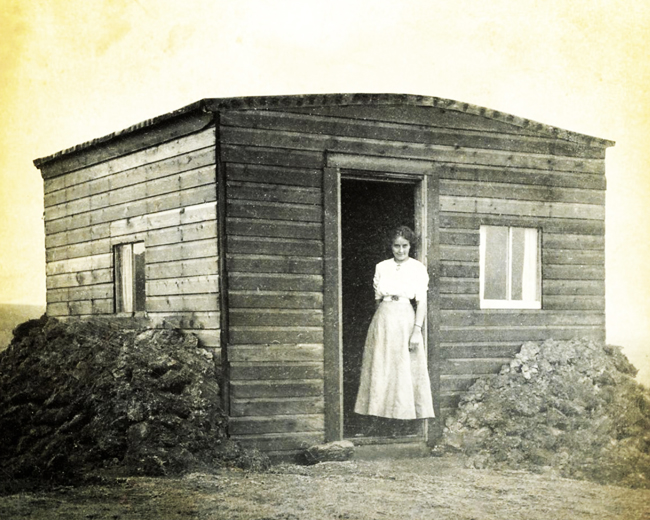Homesteaders survived that first ghastly winter in shacks made of lumber, logs or even earth. Flora, the heroine in my new historical novel, was one of them.

My Historical Journey
I write historical fiction. In Letters From Windermere, I share information about my historical research, my writing journey, and my favorite books.
In my new novel, my Scottish heroine Flora moves to a remote area of central Alberta in 1905 and stakes her claim. I expect to have a title and a cover for my book within the next few months, and you will read about it here first! Sign up for my blog or follow along if you want to stay in touch.
(The image above is from the cover of an excellent book titled Montana Women Homesteaders: A Field of One’s Own, by Sarah Carter of Edmonton, Alberta, published by Farcountry Press.)
Homesteaders were allowed to claim one hundred and sixty acres of free land under the Homestead Act (similar in both Canada and the United States). They had to create a habitable dwelling and live in it for three years, plus cultivate a total of thirty acres.
The recent cold snap had me wondering how they managed to stay alive with nothing between them and the great outdoors except one or two layers of uninsulated wood, and woollen blankets.
No statistics exist (or none that I can find), but since the success rate for homesteaders was only fifty percent, it’s fair to assume that some of those people froze to death in the attempt.
My Grandfather’s Tale
My grandfather told me this story, heard when he was a boy in Battleford, Saskatchewan: the local North-West Mounted Police officer went out on horseback after a blizzard to check on the homesteaders in his area. He was riding along when his horse stumbled against something sticking out of the snow. It was a stovepipe. The Mountie dug down and found that the homesteader’s shack was buried and the poor man’s frozen body was inside.
Homesteaders were resourceful
These first shacks were constructed of wood or earth. If you arrived with some money, you could buy what amounted to a tiny house kit including milled lumber, windows and a door. One layer of rough lumber was covered with tarpaper, and then finished with a second layer of boards.
It was a far cry from the comfortable homes many of the homesteaders left behind, although those who stuck it out eventually were able to build a more habitable dwelling. Usually their first home wound up as a chicken coop or a storage shed. This one still stands in Saskatchewan.

This photo is sardonically titled Bachelor’s Palace, in Maymont, Saskatchewan, 1911.

Sometimes the homesteaders didn’t have enough money to finish their home and they made shift with a canvas roof or even a tent, at least during the summer.

If you were lucky enough to have trees nearby (of course, this meant you probably had to clear the stumps from your land before you plowed) you could build your shelter from logs. How was it possible to keep the howling wind from blowing between the cracks? The only solution was to chink the cracks with mud or manure.

During my research, I read forty-eight memoirs by pioneers, written either by the original settlers or their children. One of the best was titled Kalyna, by Pam Clark of Calgary, who describes how a pair of young Ukrainian immigrants fashioned their first home in northern Alberta out of sticks and branches!

Another method used by homesteaders involved cutting rectangles of sod from the virgin prairie and stacking them together like ice blocks in an igloo. The dirt was held together with grass roots. A home like this was called a soddy.

This soddy was fairly large, to shelter the horses as well as the humans.

A third method was a dugout, where if you were lucky enough to find a suitable hill you dug a hole into it and then built a front wall out of boards. Here a young Ukrainian girl stands outside an earthen dugout.
The Wilder family lived in a dugout, described in the autobiographical book On the Banks of Plum Creek, by Laura Ingalls Wilder. Apparently insects and mice and even snakes were a big problem!

Of all the memoirs by homesteaders that I read, the one that really sticks in my mind is Gully Farm by Mary Hiemstra, who was only six years old in 1903 when her family came from England and homesteaded east of Lloydminster, Alberta.
She describes that first terrible winter, when everyone huddled around the wood stove to keep alive, rotating frequently because either their backs or their fronts were always freezing.

However, the successful homesteaders not only survived, but thrived. Many residents of Western Canada and the U.S. today can claim homesteaders in their own heritage. They came from Europe for a better life, and they found one.
Or to be more precise, they carved one out of the wilderness with their bare hands.
* * * * *
My Writing Journey
In April, my writing journey will take me far from the early West: across the Atlantic Ocean on the Queen Mary 2! I have signed up for the Craft & Publishing Voyage. Thirty writers will enjoy instruction every morning from four highly-qualified teachers, and the rest of the day we will be free to wander around this beautiful vessel.

The Queen Mary Two (launched in 2004) is not a cruise ship. She is the only ocean liner in service in the world, built for speed, with a regular scheduled passage between Southampton, England, and New York City. This is the flagship of the famous Cunard line.

With fifteen restaurants, five swimming pools, and the largest library at sea, there will be no shortage of things to explore. I’ll take lots of photographs to share with you in May when I get home!
* * * * *
Book of the Month
I read across a variety of genres, but naturally I enjoy historical fiction. This novel, News of the World, was made into a movie with Tom Hanks, but do yourself a favor and READ THE BOOK FIRST.
It is a moving account of an older gentleman who agrees to escort a little girl across Texas to find her family, and together they face all kinds of exciting and terrifying adventures. It’s also a great recommendation for a Book Club.

* * * * *
Reader of the Month
From ninety-year-old June Stagg in Calgary, Alberta, comes this little story.

Music and Me: My First Music Lesson
By June (Lovlin) Stagg
I’ve always had a love of music in my heart –– classical, movie musicals, the old songs that mom sang to us, the hit parade songs played on the radio, and nursery rhymes which I sang when I babysat the neighbour’s three girls.
When I was eleven years old, my sister and I, with our mom, took the train from Grimshaw, Alberta to Moose Jaw, Saskatchewan to visit a friend. It was our first train ride. We travelled frugally, so we sat up all night (no berths) and ate peanut butter and jam sandwiches. We arrived safely and the family took us to their home.
They had a piano in their living room! Mom’s friend Aunt Margaret taught me to play the first song she had learned, using mostly the black keys. Between learning to play that “no name” song and going to the theatre to watch the latest Donald O’Connor and Peggy Ryan musicals, we passed the first week.
The second week started with Aunt Margaret showing me where the notes were on the staff. From those few first steps I found her hymn book and spent the last week learning to play Nearer My God to Thee. I was hooked!
When we got home, Mom said: “I guess we have to get a piano!” In the meantime, I started taking music lessons from the minister’s wife at 25 cents per hour and practiced every day at the neighbour’s house.
My Mom, a Norwegian lady who spoke broken English, got out the Free Press and Prairie Farmer and the Peace River Record Gazette, and pored through the ads. She found a piano in Toronto, so she offered to pay for shipping the piano to Grimshaw, and would send a grain cheque for $200 for the piano. The deal was sealed and in three weeks, our piano arrived. We borrowed a truck to bring it from Grimshaw to our home in North Star, Alberta.
By this time both my sister and I were taking lessons. One of the things the minister’s wife made us do was to pick a song and we had to sing it and chord to it until we could hear the chord changes. This is how I learned to play by ear. I taught my older brother Lloyd and he never took a music lesson.
The original piano was left behind when I moved away. But even today my piano is my relaxation, my therapy and my solace. I usually go to my piano when I hear a song on the radio or TV that I like, to see if I can play it!
Thank you, June, for that lovely story. I hope you enjoy tickling the ivories for years to come.
* * * * *
Friends, please note that my Letters From Windermere will appear in your inbox every third Wednesday of each month. Put it on your calendar, and if you don’t find it, check your junk mail or send me a message and ask me where it is! You will hear from me again on March 20, 2024. As always, please refer me to your friends who are interested in history, writing, or books.
Affectionately, Elinor
